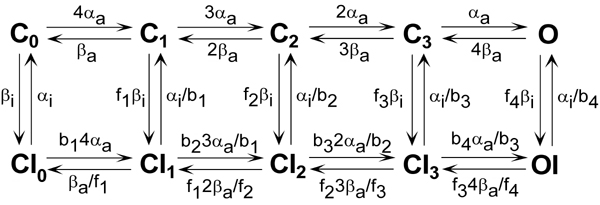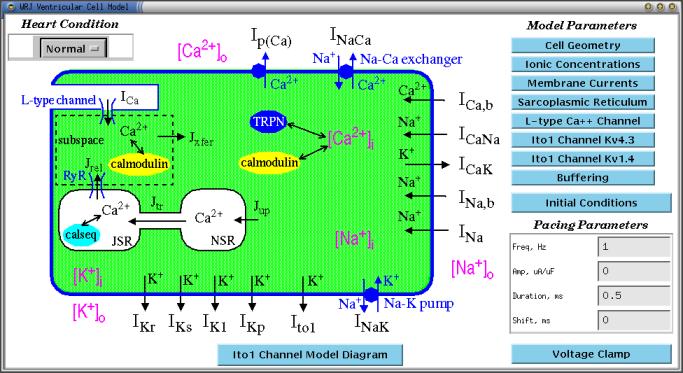The Ito1 model shown below was recently developed by Joseph L. Greenstein (Greenstein JL, Wu R, Po S, Tomaselli GF, Winslow RL. Role of the Calcium-Independent Transient Outward Current Ito1 in Shaping Action Potential Morphology and Duration. Circ Res. 87:1026-1033, 2000). For a detailed description of this model, please see the online data supplement for this article, which can be found at http://www.circresaha.org.

The model of canine Ito1 is formulated as the combination of these Kv4.3 and Kv1.4 currents, and is incorporated in the Winslow-Rice-Jafri canine ventricular cell model (Circ. Res. 84:571-586, 1999).

Two models are implemented: one is for Ito1 alone, and the other one integrates the Ito1 channel model into a cell model (WRJ3). The implementation of the two models are based on the above two papers and the integrative cell model corresponds to the Version 3 of the Canine Ventricular Cell Model originally developed at Dr. Raimond Winslow's laboratory. We wrote model description files (
and
) containing the published equations, model parameter values and initial conditions. The WRJ3 model program was then generated automatically with our new java-based model simulation environment, JSIM (Currently, the runtime model control interface is XSIM, which allows users at runtime to control parameter values, result display, data analysis, sensitivity analysis, etc).
The modeling software and the two models are free for download.
-
Using the Model via Internet
In order to run the model, you need to have a X-server installed and running on your system. There are two ways to use the on-line model simulation. Choose one of the following methods that is suited to your internet connection:
First method: if your computer is not behind a firewall, you can run the model directly through the web by clicking on the parameter file names in the next section, for example, circres00_fig2a.par.
Second method: if your machine is behind a firewall, you can run the model with the secure shell, SSH.
ssh nsr.bioeng.washington.edu -p 1234 <filename>
Replace <filename> with one of the parameter files in the next section, for example, circres00_fig2a.par. Read the FAQ if you have problems.
After you start the model, you will get two windows shown up on your screen. The small window is the XSIM control window. The big window shows the model diagram. Move the windows around, so you can see both clearly.
You can then click on the run button in the XSIM control window to start a simulation run. Click on the "results" and choose "Plot Area 1" and "Plot Area 2" to view the results. See our on-line XSIM User Manual for the complete description of XSIM functionalities.
Five simulations have been set up to reproduce the figures that appeared in the Circ. Res. paper by Greenstein et al., 2000.
Figure 2a. Electrophysiological characteristics of the model-simulated hKv4.3 currents at 35 oC. (file: circres00_fig2a.par)
Figure 3a. Voltage-dependence of peak current for the IKv1.4 model at room temperature. Peak current-voltage relationship normalized to the peak current at +100 mV. (file: circres00_fig3a.par)
Figure 4a. Canine Ito1 model electrophysiological characteristics at 35 oC. Peak current-voltage relationship simulated from a holding potential of -80 mV and normalized to the peak current at +60 mV. (file: circres00_fig4a.par)
Note: The parameters of the Kv1.4 model were fit based on data obtained at room temperature (21 oC) and were then scaled to 35 o C using a Q10 value of 3.6 based on measurements of inactivation kinetics made on native Ito1 (see the online data supplement to Greenstein et al. for details). The calculation of the scaling factor is
Q10(T-294)/10 = 6 when the temperature T=308 K (or 35 oC).
Note that the scaling factor needs to be applied to only four parameters, alphaa0, betaa0, alphai0 and betai0, in order to scale all transition rates in the Kv1.4 model.
Figure 5a. Effect of IKv4.3 current density on canine action potential shape and duration (1 Hz steady-state). Action potentials simulated with the WRJ canine ventricular cell model with increasing values of GKv4.3. (file: circres00_fig5a.par)
Figure 6. Effects of IKv4.3 current density on canine action potential, open probability of the L-type Ca2+ channel and L-type Ca2+ current magnitude. (file: circres00_fig6.par)
Simulation of heart failure
The model is implemented so that two different conditions, normal and congestive heart failure (CHF), can be simulated by toggling a switch. An example is given here of the action potential at normal and CHF conditions. (file: ap_chf.par)
Exploring underlying mechanisms
With J2XSIM, users can easily modify the model equations (
and
and generate new models without programming.
User contributions
If you have interesting parameter sets that you want to share with others, please contact us. Here is an example from Dr. James Bassingthwaighte:
-
Influences of external and internal inoic concentrations on the action potential. (file: CaoIncr.par)
The NSR would like to thank Joseph Greenstein and Dr. Raimond Winslow for their help during the model implementation and verification process.
|